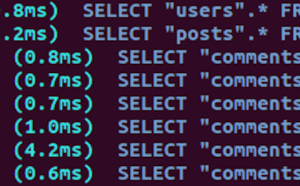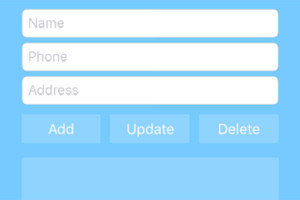Bootstrap UI Libraries for Angular, React and Vue.js

Key Takeaways
- The article presents a number of Bootstrap-styled UI libraries that can be integrated with JavaScript frameworks Angular, React, and Vue.js, enhancing the look and feel of single page applications (SPAs).
- For Angular, ng-bootstrap and ngx-bootstrap are recommended, both of which are free, open-source, and do not require any Bootstrap JavaScript files. For React, reactstrap, React-Bootstrap, and Material Design for Bootstrap are suggested, all of which provide Bootstrap-styled components without the need for jQuery or Bootstrap JS. For Vue.js, Bootstrap-Vue is highlighted as a comprehensive implementation of Bootstrap V4 components and grid system.
- The author emphasizes that these libraries are fully functional, work out of the box with the respective JavaScript frameworks, and require no extra effort from developers. They provide a convenient way to give SPAs a Bootstrap look and feel.
This article lists a number of resources that provide Bootstrap components for your Angular, React, and Vue.js apps.
These days, the web is populated with single page applications (SPAs) which feel fast and responsive to user interaction. Often, they’re powered by JavaScript frameworks like Angular, React, and Vue.js.
These libraries are great tools that help keep the JavaScript code needed to build SPAs more organized and maintainable, while using clever techniques to update the DOM without slowing down the web page.
When it comes to styling the components you can create with these libraries, you’re spoilt for choice: you can write your own global CSS document as you normally would on regular websites, you can write inline styles, or you can use UI frameworks — which is what I’ll focus on here.
Bootstrap Interface Elements for Angular Developers
Angular is the oldest of the frameworks I deal with in this article. Its maturity and long life in the brutal life cycle of JavaScript frameworks is a sign of its robust and reliable foundation for web projects.
What tools are out there if you want to use Bootstrap to style your Angular app?
ng-bootstrap
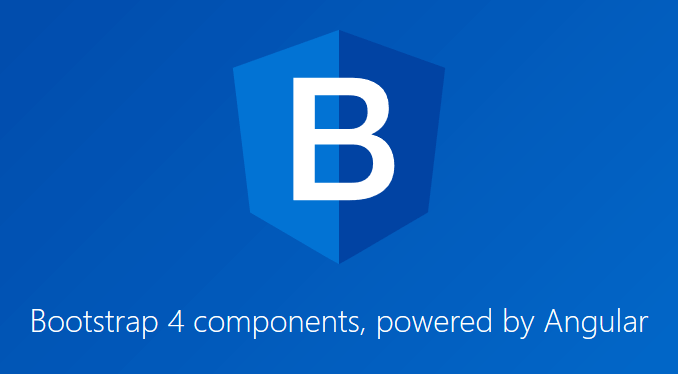
ng-bootstrap offers a set of Bootstrap-styled components that makes building Bootstrap apps with Angular a breeze.
More specifically, this resource contains a set of Angular directives based on Bootstrap’s markup and styles. To use it, it’s important that you don’t include any Bootstrap JavaScript files. You only need Angular and Bootstrap CSS files.
ng-bootstrap is a free and open-source project. Feel free to contribute to it or ask for new features on GitHub.
ngx-bootstrap
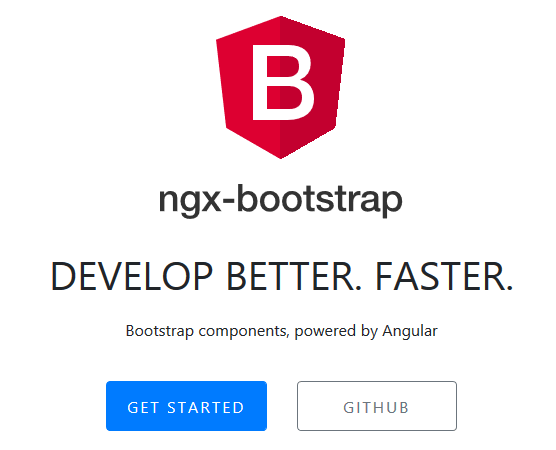
This is another great, open-source modular library of Bootstrap components powered by Angular. You don’t need to use jQuery or any Bootstrap JS code, although the markup and CSS are provided by Bootstrap.
To install the library using npm, type this line into the command line:
npm install ngx-bootstrap --saveThen include the link to Bootstrap’s stylesheet in index.html document:
<link href="https://maxcdn.bootstrapcdn.com/bootstrap/4.0.0/css/bootstrap.min.css" rel="stylesheet">You can refer to the awesome docs pages on the ngx-bootstrap website for detailed explanations and tutorials.
Bootstrap Interface Elements for React Developers
React was created by the Facebook devs and is one of the trendiest JavaScript libraries for building modern user interfaces.
If you’re looking to give your React app a Bootstrap makeover, here are some of the options available to you out there.
reactstrap
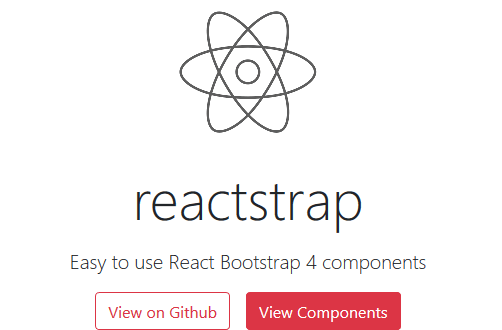
reactstrap is a fast and convenient library that lets you add a Bootstrap 4 look and feel to your React app.
The styling is provided by Bootstrap, while the JavaScript functionality is built into reactstrap components. This means that you don’t need to include any jQuery or Bootstrap JS code. However, you need to include react-popper, since some dynamic Bootstrap components like dropdowns depend on Popper.js to work properly.
You can install reactstrap via a CDN:
<link rel="stylesheet" href="https://cdnjs.cloudflare.com/ajax/libs/reactstrap/4.8.0/reactstrap.min.js">In this case, you need to include the React library and ReactTransitionGroup before reactstrap.
You can also install the library and all dependencies with NPM:
npm install --save reactstrap@next react react-domIf you’re curious, hop over to the docs and learn more about each component and how to integrate reactstrap with the Create React App setup.
React-Bootstrap
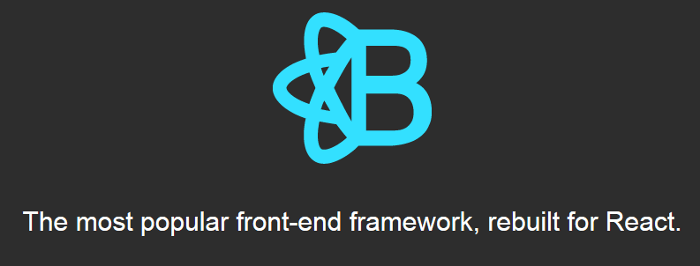
React-Bootstrap is an open-source project which is still under active development to reach the 1.0.0 release.
Since this library doesn’t support any specific Bootstrap version, you’re free to include any Bootstrap stylesheet you think best suits your project. Generally speaking, including the latest Bootstrap release will ensure that you enjoy the benefits of improvements and bug fixes, so this should be your preferred option.
The most straightforward way of including Bootstrap in your React app is via a CDN:
<link rel="stylesheet" href="https://maxcdn.bootstrapcdn.com/bootstrap/4.0.0/css/bootstrap.min.css">On the JavaScript front, you just need React; no jQuery or Bootstrap JS is required for Rect-Bootstrap to work. You can install this Bootstrap UI library using NPM:
npm install --save react react-dom
npm install --save react-bootstrapInstalling the library this way will allow you to import individual components from react-bootstrap/lib rather than the entire library. Doing so pulls in only the individual components you need rather than the entire package, which is great for keeping the file size under control.
Alternatively, you can include React-Bootstrap and the React library as a bundle using CDNJS and reference the files in your <script> tags:
<script src="https://cdnjs.cloudflare.com/ajax/libs/react/<react-version>/react.min.js"></script>
<script src="https://cdnjs.cloudflare.com/ajax/libs/react/<react-version>/react-dom.min.js"></script>
<script src="https://cdnjs.cloudflare.com/ajax/libs/react-bootstrap/<version>/react-bootstrap.min.js"></script>Material Design for Bootstrap React Version
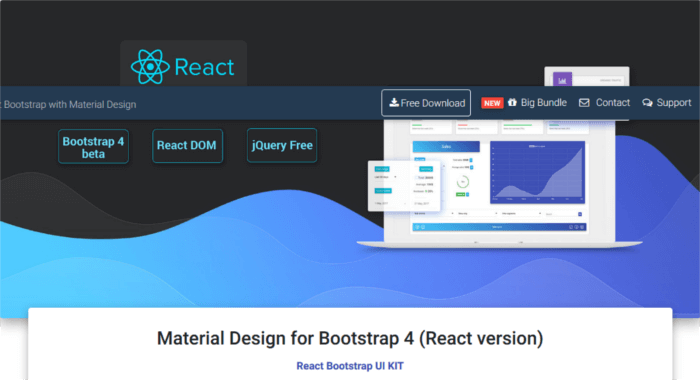
Material Design for Bootstrap (also available for Angular and Vue) is a UI library for React that combines the look and feel of Bootstrap and Google’s Material Design.
Among its advantages are:
- being up to date with the latest release of Bootstrap
- its awesome documentation and tutorials
- being compatible with the latest release of React
- its use of JSX
- its easy installation
- being free for personal and commercial projects.
To get started with Material Design for Bootstrap, just download it straight from the project’s website, or use NPM:
npm install mdbreactyarn add mdbreactOnce you’ve got the files, everything is linked appropriately and ready to go. Run npm install then npm start and get coding.
Bootstrap Interface Elements for Vue Developers
Vue.js hasn’t been around long, but it’s steadily been gaining ground in popularity due to a number of benefits that come with it:
- it’s easy to get started: you can quickly include it in an HTML project via a CDN and incorporate it in your regular HTML document using its directives
- you can decide to incorporate Vue incrementally by starting with a few features and eventually embrace it as a full-blown framework
- it has a small file size and it’s very performant out of the box.
To integrate Bootstrap into your Vue-based app, Bootstrap-Vue is a nice option.
Bootstrap-Vue
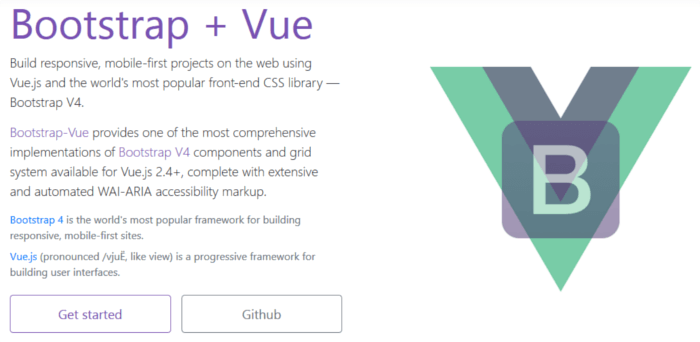
Bootstrap-Vue introduces itself on its website as the UI library that:
provides one of the most comprehensive implementations of Bootstrap V4 components and grid system available for Vue.js 2.4+, complete with extensive and automated WAI-ARIA accessibility markup.
The documentation is great and you can also try out the library before including it in your project on the Bootstrap-Vue playground.
Conclusion
This article has listed a number of UI libraries to help you give your SPA’s components a Bootstrap look and feel. These are fully functional Bootstrap components that work with Angular, React, and Vue out of the box, without extra work required from you.
What’s your favorite way of integrating Bootstrap with your JavaScript framework of choice?
Frequently Asked Questions (FAQs) on Bootstrap UI Libraries for Angular, React, and Vue
What are the key differences between Bootstrap, Angular, React, and Vue UI libraries?
Bootstrap, Angular, React, and Vue are all popular UI libraries, but they have distinct differences. Bootstrap is a CSS framework that provides pre-styled components, making it easier to design websites. Angular, on the other hand, is a full-fledged JavaScript framework that provides a structured approach to developing web applications. React is a JavaScript library for building user interfaces, particularly for single-page applications. It’s known for its virtual DOM feature that enhances application performance. Vue is also a JavaScript framework, but it’s known for its simplicity and ease of use, especially for beginners. It’s a progressive framework, meaning you can adopt its features incrementally.
How do I choose between Bootstrap, Angular, React, and Vue for my project?
The choice between Bootstrap, Angular, React, and Vue depends on several factors. If you need a simple, responsive design with minimal JavaScript, Bootstrap might be the best choice. If you’re building a large-scale, complex application, Angular’s structured approach could be beneficial. React is a good choice if you’re building a high-performance, single-page application. Vue is ideal if you’re a beginner or if you need a simple, yet powerful framework for your application. Consider your project requirements, your team’s expertise, and the specific features of each library before making a decision.
Can I use Bootstrap with Angular, React, or Vue?
Yes, you can use Bootstrap with Angular, React, or Vue. Bootstrap provides pre-styled components that you can use within your Angular, React, or Vue application. There are also specific versions of Bootstrap designed for use with these libraries, such as ng-bootstrap for Angular and react-bootstrap for React.
What are the advantages of using Bootstrap for my project?
Bootstrap offers several advantages for your project. It provides a responsive grid system, pre-styled components, and JavaScript plugins that can speed up your development process. It’s also widely used, which means there’s a large community and plenty of resources for help.
What are the advantages of using Angular for my project?
Angular is a powerful framework that provides a structured approach to developing web applications. It supports two-way data binding, dependency injection, and modular development. It’s also backed by Google, which means it’s regularly updated and has a large community for support.
What are the advantages of using React for my project?
React is known for its virtual DOM feature, which enhances application performance. It also supports a component-based architecture, which can make your code more readable and maintainable. React is backed by Facebook and has a large community for support.
What are the advantages of using Vue for my project?
Vue is known for its simplicity and ease of use. It’s a progressive framework, meaning you can adopt its features incrementally. It also supports a component-based architecture and two-way data binding. Vue has a growing community and is becoming increasingly popular for web development.
Are there any disadvantages to using these libraries?
Each library has its potential disadvantages. Bootstrap might not be ideal if you need a highly customized design. Angular can have a steep learning curve, especially for beginners. React might be overkill for simple applications, and Vue, while simple, might not be as suitable for large-scale applications as Angular or React.
Can I use these libraries together?
Yes, you can use these libraries together. For example, you can use Bootstrap for styling within your Angular, React, or Vue application. However, keep in mind that each library has its own way of doing things, so combining them might require some extra effort.
Where can I learn more about these libraries?
There are many resources available for learning about these libraries. The official documentation for each library is a great place to start. There are also many online tutorials, courses, and articles available. Consider your learning style and choose the resources that work best for you.
Maria Antonietta Perna is a teacher and technical writer. She enjoys tinkering with cool CSS standards and is curious about teaching approaches to front-end code. When not coding or writing for the web, she enjoys reading philosophy books, taking long walks, and appreciating good food.



